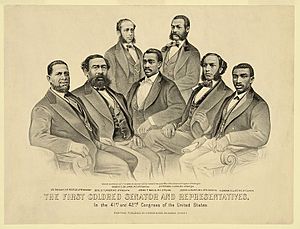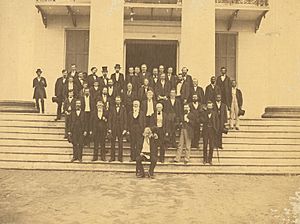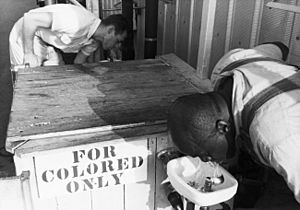Reconstruction in Alabama facts for kids
During the Reconstruction era, Alabama was under military rule by the U.S. government. A special meeting was held to create a new state constitution. This new constitution officially ended the enslavement of African Americans. New federal laws, called the Reconstruction Acts, also made sure African Americans had basic civil and political rights.
During this time, African Americans were elected to important state and local jobs. Others were chosen for public offices. New public school systems were also started, including schools and colleges especially for African Americans.
Life was hard for both White and Black people after the war. The economy was a mess, and big social changes caused problems across the state. Many former Confederate soldiers and their supporters wanted to bring back White supremacy and the old Democratic Party rule. For many in Alabama, Reconstruction was a time of civil unrest and political fights. These struggles happened before and after Alabama rejoined the United States.
Contents
Why the Civil War Happened
Big disagreements about whether human slavery was right, along with other political issues, eventually led to the American Civil War. Many people in the North started to believe that slavery was wrong because of their religious and ethical views. They felt that enslaving people went against Christian beliefs and stopped Christianity from spreading.
Northern Republicans fought for ideas like ending slavery (called abolition), equal rights for everyone, and democracy. Meanwhile, White people in the South, who formed the Confederacy, fought to protect their way of life. Their economy and society were built on slavery.
The North had more factories and resources, which helped them win the Civil War and take control of the South. About 200,000 freed Black people also joined the Union Army, which helped the North win.
After the North and South reunited as one country, new laws were passed. These laws ended slavery and gave citizenship rights to former slaves, who were called Freedmen. This period is known as Reconstruction. It focused on making sure African Americans had legal rights, especially in the South. Like other former Confederate states, Alabama had to follow Reconstruction rules. The government and people of Alabama faced big challenges because of deep-rooted prejudice and the new national laws.
New Rules for a New Era
National Changes
Before the Civil War ended, the United States passed three important changes to the Constitution. These were called amendments. They aimed to end slavery and give basic rights to African Americans.
- The Thirteenth Amendment made slavery illegal. The only exception was as a punishment for a crime.
- The Fourteenth Amendment said that anyone born in the United States was a citizen. This meant former slaves were now citizens.
- The Fifteenth Amendment gave all men the right to vote. It made it illegal to stop someone from voting because of their race.
It's important to remember that while these amendments aimed for more equality among men, they did not address unfair treatment based on gender.
The Civil War was mostly fought in the South. So, the Southern states had to rebuild their economies, governments, and societies. Many people in the South, and even some federal leaders, thought life would go back to how it was before the war. Andrew Johnson, who was president, agreed with this idea. He was later removed from office because he didn't do enough to support the rights of Black people.
After Johnson, the U.S. government, led by the North, passed laws to help Black people become part of society and gain political rights. This time, known as Reconstruction, generally lasted from late 1863 to 1877.
Alabama's State Rules
To rejoin the Union and follow Reconstruction, Alabama had to promise loyalty to the U.S. and change its state constitution. The new constitution used words similar to the Declaration of Independence. It said: "That all men are created equal; that they are endowed by their Creator with certain inalienable rights; that among these are life, liberty, and the pursuit of happiness."
The state also declared: "That all persons resident in this state, born in the United States, or naturalized, or who shall have legally declared their intention to become citizens of the United States, are hereby declared citizens of the State of Alabama, possessing equal civil and political rights and public privileges." Even with these changes in legal documents, Alabama and other Southern states found it hard to truly put these changes into practice.

Life During Reconstruction
For Black communities, Reconstruction brought new chances but also strong opposition from White supremacists. Violence and unfair treatment made many Black Americans fear for their lives. Efforts to stop them from voting led many Black Americans to organize and unite, often through their churches, to fight for their rights.
Laws that limited voting and other unfair social rules were designed to keep Black people from having equal power. For White communities, Reconstruction was a time of fear that their traditions and social order would change. Poorer White people worried that Black people would take their jobs. This led to more segregation across the state. As Black communities united to fight for their rights, many White people joined together to keep White supremacist social norms in place.
During Reconstruction in Alabama, church meetings were a very important way to share information and influence people. Both White and Black preachers spoke about what was happening in the country and in their local areas. W. E. B. Du Bois, a famous writer, said that Black preachers were "A leader, a politician, an orator, a ‘boss,’ an intriguer, an idealist” all in one. Preachers shaped how people saw Reconstruction and the violence in Alabama.
Newspapers also helped spread information. Papers were as divided as the people. Some White supremacist newspapers promoted the idea of White people controlling and restricting the Black population. Newspapers for African Americans spoke about equality, both politically and socially. They also reported on the violence happening in Alabama. Through church meetings and newspapers, Alabama was a state divided by different ideas during Reconstruction. However, in 1901, a new state Constitution was written. It provided clearer and stricter language about the equality of all men, which helped end the Reconstruction debates in the state.
Racism and White Supremacy
The Ku Klux Klan
As Reconstruction continued in Alabama, the Ku Klux Klan, or KKK, became more and more violent. They set houses on fire in Black communities. They also carried out "night rides," where they raided homes and lynched many people.
Over time, support for the KKK and other White supremacy groups began to decrease. This happened as the Black community united for safety. Large numbers of Black people moved into close communities where they outnumbered nearby White communities. This gave them more security and safety from the KKK. Even though racism and segregation remained strong in Alabama, house burnings and lynchings started to happen less often. Many White people still believed in the ideas of the Confederacy. They thought Black people should be slaves and that Black suffrage (Black people voting) was wrong and would ruin Alabama.
New Forms of White Supremacy
As the KKK's power lessened because Black people came together for safety, new forms of White supremacy appeared. One way White supremacy groups tried to limit the freedoms of Black people was through politics. Many White people wanted to distance themselves from Black voters. Many Black voters felt they couldn't trust any White person. These ideas led to split political parties and arguments over Reconstruction issues. White supremacy groups worked together to break Black unity in voting and pass more restrictive laws in Alabama.
Another area White supremacy groups focused on was the workforce. After the Civil War, many White people believed that the workforce would stay the same, with Black people doing most of the work for low wages. White people used unions to gain social and economic advantages. They enforced discrimination and kept better jobs and working conditions for themselves. Because of this, many White people denied Black people their rights in the workforce. This forced many Black people to move to find more freedom and keep their families together. For many Black people during Reconstruction in Alabama, the biggest problem was not just the KKK, but White supremacist groups who wanted to keep things exactly as they had been.
Jim Crow Laws
Even though the new constitution promised voting and other rights to everyone, no matter their race, these promises were hard to enforce. Over time, the laws of Reconstruction were weakened or ignored. Presidents like Andrew Jackson and others gave the South more freedom to create and enforce laws that supported segregation and took rights away from Black people.
In 1874, a former Confederate governor named George S. Houston was elected. He, along with many other elected White supremacists, ended the Reconstruction era in Alabama. This period was known as Redemption. As the Democratic Party gained more power, the Republican Party, which had supported ending slavery and equal rights, became weaker.
During the Constitutional Convention of 1901, many measures were written into law to segregate and take away voting rights from African Americans. Besides written laws, Black segregation was also enforced by the long-held prejudices of the people. Cities and public places, including buildings, were often designed with separate spaces for Black and White people. Overall, these policies and social practices created a barrier between Black people and their Constitutional rights. This lasted through the Civil Rights movement and even beyond.



